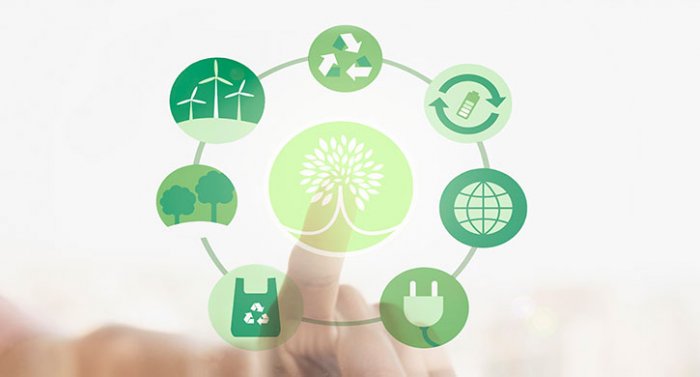
Building a circular economy strategy is no longer simply about improving a company’s reputation. It is new economic model that provides a pragmatic response to climate change problems, and improves economic and social performance.

The 6th IPCC report provides an alarming assessment of global warming. Now undeniable, this reality drives us to radically decarbonize our economies. Moving from an “Extract, Manufacture, Discard” linear development model to a “Reuse, Repair, Recycle” model based on the circular economy is one of the levers for achieving these decarbonization objectives. What preconceptions are holding back the implementation of large-scale circular economy policies, and what changes will companies have to make?
There are all sorts of societal challenges which our companies have to face, such as global warming or the depletion of natural resources (the Earth Overshoot Day continues to advance). Our society is increasingly vulnerable faced with these challenges.
As we saw during the recent global pandemic, the shortage of electronic components, mainly produced in Asia, has highlighted the growing interdependence of the global economy... It is becoming vital for companies to radically change their development models in favor of a more virtuous model based on the circular economy.
But obstacles remain in this regard.
Misconceptions about second-hand equipment and the circular economy
No, reconditioned equipment is no less reliable than new equipment. Once a requalification process is implemented, this equipment is at least as reliable as any new item of equipment.
No, the circular economy is not an obstacle to the digital transition. The two are even very closely linked: thanks to reconditioned PCs and smartphones, access to high-speed Internet connections becomes an opportunity for everyone by targeting low-income households. Furthermore, by using reconditioned IT equipment and telecom networks, telecom operators can deploy the Internet at low cost in less profitable areas with a low population density, as well as in white areas.
No, the circular economy is not a growth lever exclusively reserved for emerging countries. It concerns the entire planet: the circular economy prompts economic growth, competitiveness and better profitability by developing new products and services, and by creating jobs and relocating activities.
The circular economy: a necessary paradigm shift
Faced with social and environmental challenges, companies must adapt by integrating the circular economy at the very heart of their strategy. For this purpose, they must implement ambitious programs combining eco-design, use of reconditioned equipment, repair, recycling and information both internally and with customers.
More specifically, in order to successfully transition to the circular economy, companies must get mobilized at several levels. Here are some initiatives to set up this approach within the company:
- Review purchasing strategies by stepping up the use of refurbished equipment or dormant stock within the company.
- Spur a product eco-design approach by integrating repair, reuse and recycling right from the product design phase. This approach is also a tremendous source of innovation for companies. Waste transformation involves developing new skills and professions to rethink the production chain within the company. This approach also helps with creating jobs and developing new sectors such as repair, re-employment or recycling. Finally, it can also be an opportunity to relocate these new jobs back to national soil, as close as possible to companies.
- Establish change dynamics by raising awareness of circular economy issues among the company's stakeholders. The aim is to inform, educate and train the company's stakeholders, i.e. its employees, but also:
- its suppliers, by integrating the concepts of circular economy and eco-design into calls for tender in order to increase the sustainability of products: use of renewable resources, waste recovery (repair, recycling, etc.);
- and its customers, to inform them of the environmental impact of their equipment (telephone, box, etc.) and its uses. It also provides a means of removing certain barriers, for example on the use of reconditioned equipment.
Examples of circular economy initiatives among telecom operators
With more than a billion mobile telephones sold each year, and considering that networks must evolve with the arrival of 5G, telecom operators are particularly concerned by the challenges of the circular economy.
The Joint Audit Co-operation (JAC), a collaborative initiative that brings together 17 major operators, aims to raise supplier awareness of sustainable development issues in order to ensure compliance with internationally recognized standards throughout the ICT supply chain, as well as respect for human rights and social, environmental and labor standards.
Orange Group plans to reach net zero carbon emissions by 2040. With this in mind, it has launched several circular economy initiatives, including a program dubbed OSCAR1 to put the circular economy at the heart of infrastructure networks. The reuse – whenever possible – of existing refurbished equipment helps to reduce CO2 emissions: it avoids the production of new equipment while improving the group's operational performance.
For example, following the network sharing agreements signed in Spain2 and Belgium3, dismantled equipment will be placed online on the Orange marketplace so that it can be easily redeployed in other countries of the Group.
Vodafone also aims to achieve carbon neutrality by 2040, and is committed to reducing electronic waste, with a target for reusing, reselling or recycling 100% of its network waste by 2025.
Equipment manufacturers are also involved: for example, CISCO with its offer of reconditioned products via its CISCO refresh program, or Juniper and its PureWrx-certified reconditioned equipment offer.
Building a circular economy strategy is no longer simply about improving a company’s reputation. It is new economic model that provides a pragmatic response to climate change problems, and improves economic and social performance. This model promotes growth and competitiveness for the company, and helps create jobs.





